Bibliotheca Junetorial: Identifying Mystery Items
This month’s theme for Biblotheca is tutorials! Also, if you came here from the Biblotheca site/ newsletter, welcome! I just applied to join in May, so this is my first month’s post for Biblotheca and I’m excited to be a part of the blog circle. I was trying to think of something I could write a tutorial on that I haven’t touched on already, and I realized that identifying things is something that likely would be useful to both new and older lolita alike.
Step 1: Identify the brand
Figuring out the brand of a piece is going to make the rest of the process far more simple. If you have the piece in your hands, look at the inside for a brand tag. If there isn’t a logo tag, look for a tag with washing instructions. The brand name is often on these tags, usually at the top or the bottom near the ‘made in ____’ part, sometimes in Japanese or Chinese. If you have a piece of clothing (not an accessory) and it doesn’t have either of these tags, there is a high likelihood that it’s handmade or from a very small indie brand and may be one of a kind.
If the tag is in a language you don’t know, like Japanese, hop over to google translate.
Using Google Translate for Text You Can’t Just Copy-Paste
We are going to select the language and then use the handwriting option by clicking the tiny pencil:
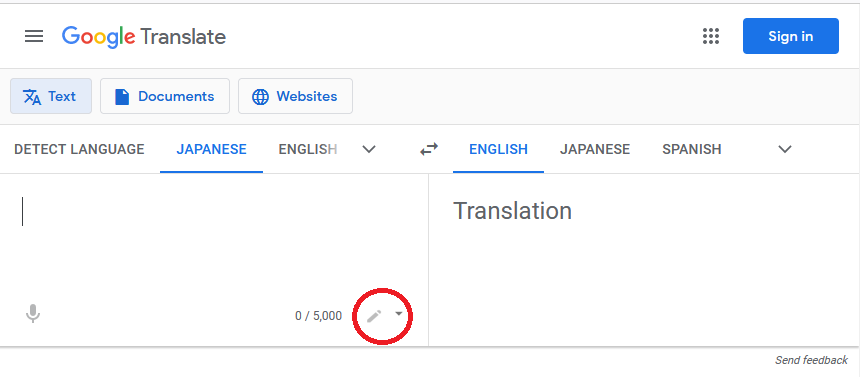
And then you just try to draw the Japanese or Chinese characters. You don’t have be perfect, and you can try again if you don’t do a good enough job for the translate app to figure it out. I like the desktop version because it doesn’t move on until you click on a character, but there is also a version of this in the google translate phone app.
Click on the character at the bottom that matches what you were trying to draw. If you want to start over, click the little dark arrow with the x in it on the bottom left.
If you use the phone app, there is also a photo version. I find it works well for clear text that is black on a white background and not too small. Stylized text like in logos, and text on top of busy images can be hard for the app to read. I like to use the version where you take a photo and then it translates instead of the version where it super-imposes the text over… it’s more accurate!
Let’s say you have a complicated Japanese character you can’t draw well. Use this guide to find a small piece of the character instead. for example, I had this handwritten character on the right in a hand-lettered catalog recently. I could make out the 己 on the bottom, so I clicked on the 己 in the guide.


That gave me these options, and I was able to figure out that it was 巻, which made the item name レース柄巻き風スカート.
If it’s a Chinese indie brand, you can also check this guide (and please submit any I don’t have!).
Once you have the brand, it’s much easier to narrow down your search!
Brands are stored in 3 places in lolibrary. Brands that have more than 10 pages of results are under the Brands section. If you don’t see the brand there, next, check the tags. You can type any part of a brand name and it should pop up if it’s there.



If a brand doesn’t come up under either of those searches, try putting the brand name in the main search box. Items from brands that are not well documented in lolibrary will have their brand name at the start of every item entry from that brand.
Step 2a: Gather the Tag Clues
Angelic Pretty
Angelic Pretty used different tags at different points. First, check for a washing tag with an item number. If there is an item number, try searching for that item number on lolibrary.


Older item numbers will be one or more letters (in this case an O) followed by a dash and then a number. Search for just that number, and then check what comes up. In this case, it was the Whipped Gingham Ruffle OP (2015). (The ring has the item number 142KA6-13716, which is why it matched the search).


Newer AP item numbers have a letter code, followed by a dash, followed by a number, then another dash and another number. Search for the number in the middle on lolibrary. In this case it was the Little Witch OP.
If there isn’t an item number on the tag, you can still use a tag guide to narrow down the date based on the style of the tag.
Baby the Stars Shine Bright / Alice and the Pirates
Baby frustratingly doesn’t give us much to work with on their tags, but you can use this guide to Baby the Stars Shine Bright tags to help narrow down a time frame.
Black Peace Now / Peace Now
If the phone number on the tag ends in 6851, it’s older (this was their number 1997-1999). If the phone number on the tag ends in 8077 it’s newer (This was their HQ number 2001-2013). I do not know exactly what year they updated the tags, so this is just a rough date range.
Tags should have item numbers, and the first digit should correspond to the year. I have not yet worked out when this loops around, my most up to date information is in this spreadsheet.
- 0 = unconfirmed
- 1 = unconfirmed
- 2 = tentatively 2000?
- 3 = 2011 OR tentatively 2001
- 4 = 2012 OR tentatively 2002
- 5 = 2013 OR 2003
- 6 = tentatively 2004
- 7 = 2005
- 8 = tentatively 2006
- 9 = tentatively 2007?
If you do identify a BPN or PN item that is not from 2011-2013, please do come tell me about it n the Item Identification channel on the Lolibrary Discord or the Rufflechat Thread.
Cornet
The color of the cornet tag can be used to roughly judge the age. From my tag guide:
- Tags which read Garaus are the oldest, most likely from the 1990s.
- 2002: Solid Blue tag with pale lettering
- 2004-2005: White tag with blue lettering
- 2005-2008: Yellow tag with blue lettering
- 2008-2009 (+2010?): Pink tag with red lettering
I document my Cornet research on tumblr, you may find some info there that isn’t yet on lolibrary.
Emily Temple Cute
If the tag says Emily Temple (no cute), that’s Emily Temple, and it’s not the same as Emily Temple Cute, but it’s documented under Emily Temple Cute on lolibrary / Lolita history. Look at catalogs marked Emily Temple on lolita history (as of right now, there is only one), and lolibrary. Look at Shirley Temple items pre-2002. You want to find anything that is the same print, or cut, just for little kids.
If the tag says Emily Temple Cute, however, we are in luck because we probably have an item number on the wash tag. Once you have the item number, do a quick search in lolibrary for that item number. If there is no match, you can try searching by year and just look for it with your eyes.
Older items have a matte paper/plastic texture to their garment tags and closer-together lettering, while newer items have a more silky fabric and more spaced out lettering.
The first two digits match up to the year.
- 10 = 2020
- 11 = 2021
- 12 = 2022
- 14 = 2014
- 16 = 2016
- 17 = 2017
- 18 = 2018
- 19 = 2019
- 50 = 2000 OR 2010
- 51 = 2011 OR 2001
- 52 = 2012 OR 2002
- 53 = 2013 OR 2003
- 54 = 2004 OR 2014
- 55 = 2005
- 56 = 2006
- 57 = 2007
- 58 = 2008
- 59 = 2009
- 64 = 2014
- 85 = 2015
- 84 = 2014
The second 2 digits match up to the item type
- 11 = Blouse 11
- 21 = Skirt
- 22 = Skirt
- 41 = NOP / OP
- 51 = NOP / OP (usually older)
- 61 = Cutsew
- 62 = Cardigan
- 96 = Cutsew
- 97 = Blouson
The last digits are sequential. So a dress with the last 3 digits 640 would have been released before one with the last 3 digits 645. The higher the number, the later in the year it probably was.
If it’s not in lolibrary, look in the sketch catalogs for the corresponding year. If you think it may be from 2005 or earlier, also check the Shirley Temple sketch catalogs for items in the same print. ETC can be found in Kera in this time frame as well.
For 2006-2014, check the nagoya blog in the wayback machine. Kyoto blog started in 2005, Osaka in 2008, and fukuoka covers 2007 – early 2009. The online shop launched in 2013 and can be viewed via the wayback machine.
The corporate name can also be used to help differentiate the time periods to some degree.
Timeline of corporate names:
Shirley Temple Co., Ltd. (株式会社シャーリーテンプル) 1999 – 2012
Emily Temple Co., Ltd. (株式会社エミリーテンプル). 2012 – 2015
Maple Design Lab Co., Ltd. (株式会社メープルデザインラボ) 2015-2016
J-Jolly Co., Ltd. (株式会社ジェイジョリー) 2016 – and on
Innocent World
Items from after 2008 will have an item number on the tag.


If there is no match on the item number in lolibrary, use the following guide to establish the year:
- 08#### = 2008
- 09#### = 2009
- 10#### = 2010
- 11#### = 2011
- 12#### = 2012
- 13#### = 2013
- 14#### = 2014
- 15#### = 2015
- 16#### = 2016
- 17#### = 2017
- 18#### = 2018
- 19#### = 2019
- 20#### = 2020
- 21#### = 2021
- 22#### = 2022
Items released in January / December may at times be back or forward dated by 1.
If there is no item number, it’s 2008 or earlier, use my tag guide or the how to be an angel one to roughly date it.
Maxicimam
Items should have item numbers on the tags. Older items may have stamped on item numbers / fiber content instead of the information being printed.
Item numbers are re-used for re-releases, so they are not always indicative of the exact release date.
Metamorphose
The last 4 numbers of the phone number on the wash tag can be used to roughly establish the dates on older items.
☎ 6400 : 2001 [x]
☎ 6434 : 2005/2006? [thank you to licoricestrudel]
☎ 6436 : 2007 [x]
☎ 6856 : 2009-2016 [x] [x]
Newer items have an item number on the tag.
The first two digits are common to all items in a long block of time. It was 10 for years, and then they started using 18, 13, 19. I don’t know the significance, except that 19 is generally crown label. Really old things don’t include the first two digits, more modern things do and I don’t know exactly when the switch was.
If you have a 6 digit item number that starts with a 1, the item is from ~2000-2001. If it starts with a 2, it’s from 2002.
If you have an 8 digit item number use the following chart for the first 4 digits where # can be any number.
- 103# = 2003
- 104# = 2004
- 105# = 2005
- 106# = 2006
- 107# = 2007
- 108#, 138# = 2008
- 1309, 19#9 = 2009
- 1300, 1800, 19#0 = 2010
- 1#01, 19#1 = 2011
- 1#02, 19#2 = 2012
- 1#03, 19#3 = 2013
- 1#04, 19#4 = 2014
- 1#05, 19#5 = 2015
- 1#06, 19#6 = 2016
- 1#07, 19#7 = 2017
- 1#08, 19#8 = 2018
- 1#09, 19#9 = 2019
- 1200, others = 2020
- 1201, others = 2021
- 1202, others = 2022
Meta will reuse an older item number for a re-release.
The next 2 digits are an item type marker, and then the last 2 of the 8 or 6 are a sequential number.
If you have a dash and then a 4 digit number after your item number, that is a color code.
You can see my work on decoding Meta item numbers in this spreadsheet, which includes the color code chart.
Putumayo
Items should have item numbers on the washing tag, I can confirm for sure that they do at least back to 2005.
If the item number on the tag starts with any letters, omit them when searching lolibrary. Also omit anything following the hyphen. So for this cutsew, I would search for 518034.
I’ve done a very small amount of work on collecting Putumayo item numbers, which you can see in my spreadsheet. I have not attempted to decode them, though the letter codes do correspond to item type (CS for cutsew, SK for skirt). You can see more tags on my tag guide.
Step 2b: Gather Context Clues
If you don’t have the item in your hands, it’s time to try to gather whatever context clues you can. First, is the image you have likely a stock photo? If so, look for any identifying features that might identify the brand. For example, a type of frame around the edge of the image, or a brand logo. If there is a weibo handle on the image, try checking that weibo page to see if it’s a specific shop’s page.
Download the image to your local computer if you haven’t already. Right-click on it, and choose properties. Check the created and modified dates of the image. Sometimes this can give you an idea of how old the image was, especially if you have had it saved for a long time. Freshly downloaded images may just show Today’s date, which isn’t super helpful.
If the image is posted online, look for other clues. Is there a date on the blog post or social media post? If so the item is at least as old as when it was posted.
For items that are for sale, check the description to see if the person mentions they bought the item a long time ago, or what the brand might be. Some people will just tag several brands or list an item in a different brand’s category for visibility though! I also will browse the other items someone is selling to see if all the items they are selling seem to be from roughly the same time frame. If so, that can sometimes indicate that this item might be of a similar age.
Step 3: Searching Lolibrary
If you have an item number start with that. If that doesn’t net you your item, put in the brand and the item type. If you have a lot of time, or there are few results, you can just page through the results at this point.
but if you are working with something like an AP JSK, we probably want to narrow down farther than this to search.
Color is a great option for search if you think it’s a common / well known item. If you think it might be a rare item from 20 years ago, color may be less reliable as we may not have every colorway listed in lolibrary because we might not know every color the item came in. When I search by color, I use the color I think it is, plus any other similar options. So for a pink dress with white lace I would put in pink, pink x white and pink x offwhite.
When I look for red things, I’ll often include wine as well if the red is at all borderline dark, and I often search for blue things under both blue and navy. Darker lavender I’ll include purple, and purple things I’ll look at both purple and wine. If the brand is something like ETC, or another “otome” brand, I’ll look at blue as well as sax because some of them will describe these sort of medium shades of blue as blue.
For features, if something is very old and has short or detachable sleeves, I’ll often look at both. This is because detachable sleeves can be lost over time, so I might own the dress and not the sleeves, or someone might have entered the dress and thought it was layered over a blouse and marked it as short sleeves.
Full shirring is a good feature for searching as well, as it’s pretty distinctive and usually attached to appropriate items. Same with scallops.
And then the tags… start with the biggest things. So if it’s a print like this:
We are going to want to look for the tags like “chess” (because of the big chess pieces) first. Stick to the biggest, most obvious parts of the print. There is a single tiny heart in the center of that crest, sure, but the chocolate, chess pieces, and diamond prints are far more obvious.
You can use the “all” matcher to see only pieces that have all the tags you entered.
For example, this will return items with both chocolate and chess tags. If you do any, it will return items with chocolates tags, items with chess tags AND items with both tags. If you do none it will return all items with neither the chocolate nor the chess tag.
I’ll sometimes try a few different combinations here, because the people who enter items into lolibrary are human and humans can miss tags, or interpret things differently. Especially when it comes to weirder colors.
If you have an idea of the year range, you can put those years into the year option to narrow it down. So, for example, if I know an AP tag is from 2003 or earlier, I can limit it to just 2000, 2001, 2002 & 2003.
The none can be used if you are certain something isn’t from a particular year or years. If you are every bored and want to do research in books, here is a quick link to all the items in lolibrary that don’t have a year.
Some things won’t be in lolibrary. If you don’t find it there, the next step is to look at other sources.
Step 4: General Image Search
The next thing I do is I hop over to google translate and google images. In google translate I put keywords that apply to the item.
So if I was holding this dress, I might look for ‘apple’ and ‘jumperskirt’.
Google translate tells me that’s アップルジャンパースカート. So I put アップルジャンパースカート and Angelic Pretty into a google image search.
And then I just browse through the image results for a match. If it’s a Chinese brand, I’ll search in English in the hopes of getting a match on a reseller site, even if I don’t know the brand name.
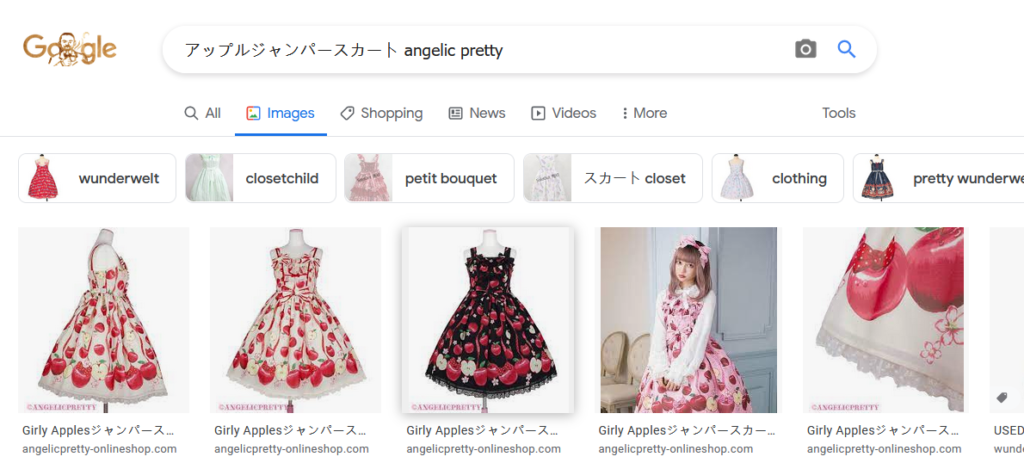
Sometimes you get lucky and the result actually says what the item is. Sometimes it doesn’t. But even if it’s an old blog post from someone who owns the item, or an old sales post, you can sometimes get a better idea of at least how old the piece is. If you find a blog post with the item in it from 2008, for example, you know it’s at least as old as 2008. Sales listings will sometimes say things like “I bought this 10 years ago” which can also be a good hint.
For brands that have active blogs, you can also try just searching their blogs. Put in your keywords and then site:blog.livedoor.jp/metamor_tsuhan-english to search just the english meta blog for example, or you can do your keywords, plus the brand name and then just the platform they blog on like site:blog.livedoor.jp to search all blogs on that platform.
Examples:
Metamorphose シャーリングジャンパースカート site:blog.livedoor.jp
search the livedoor blogging platform (where meta blogs) for entries that contain metamorphose and shirring jsk.
Pirates ローズバッグ site:https://ameblo.jp/
Search the amblo blogging platform (where baby/pirates blogs) for posts that contain pirates (aka alice and the pirates) and rose bag.
For Alice and the Pirates and Baby the Stars Shine Bright, just use Pirates and Baby, not the full name.
I also will do a search by image if I have a stock photo or someone else’s photo to see where the image might be posted. You can do an image search on Taobao as well.
Step 5: Searching the Wayback Machine
If you have some vague semblance of the year, you can try looking in the wayback machine at the brand’s web shop. If you don’t know what the URL for the brand site was at that time, start by doing a search for the brand name.

Pay attention to the year range, as some brands change their URL. I like to click on the text that says like 190,000 capture(s) to start.
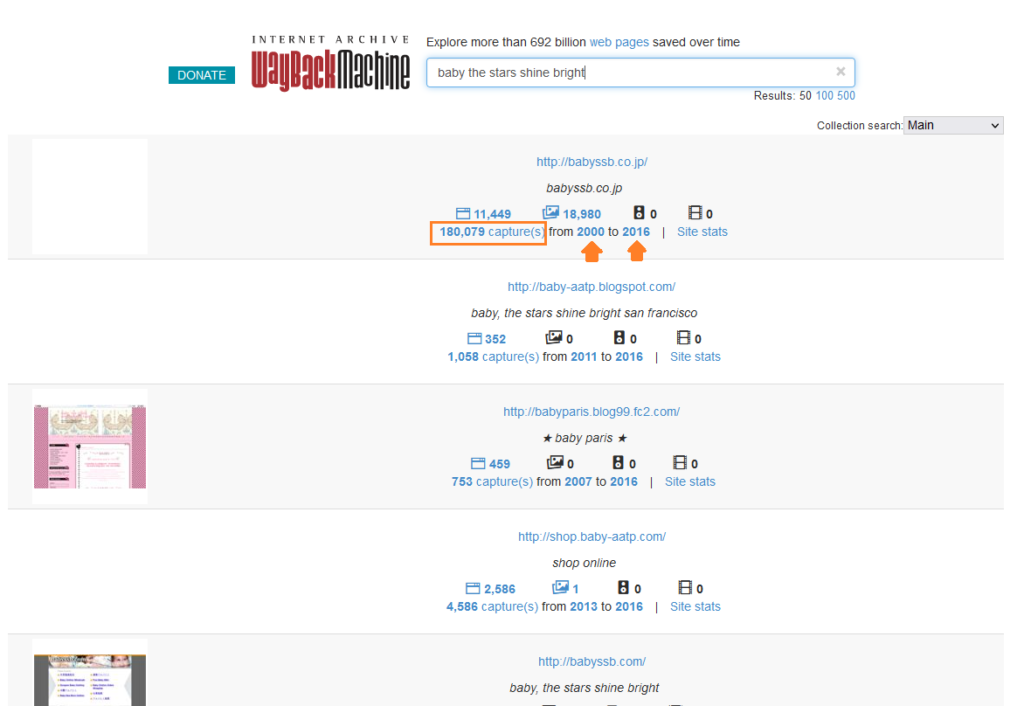
Side note: be careful, this is not like a modern web search where the results are filtered. There is questionable stuff. Make sure you know what you are clicking on….
You will get a screen like this. Click somewhere in the year you want to change the calendar on the bottom to the year you want to look at.
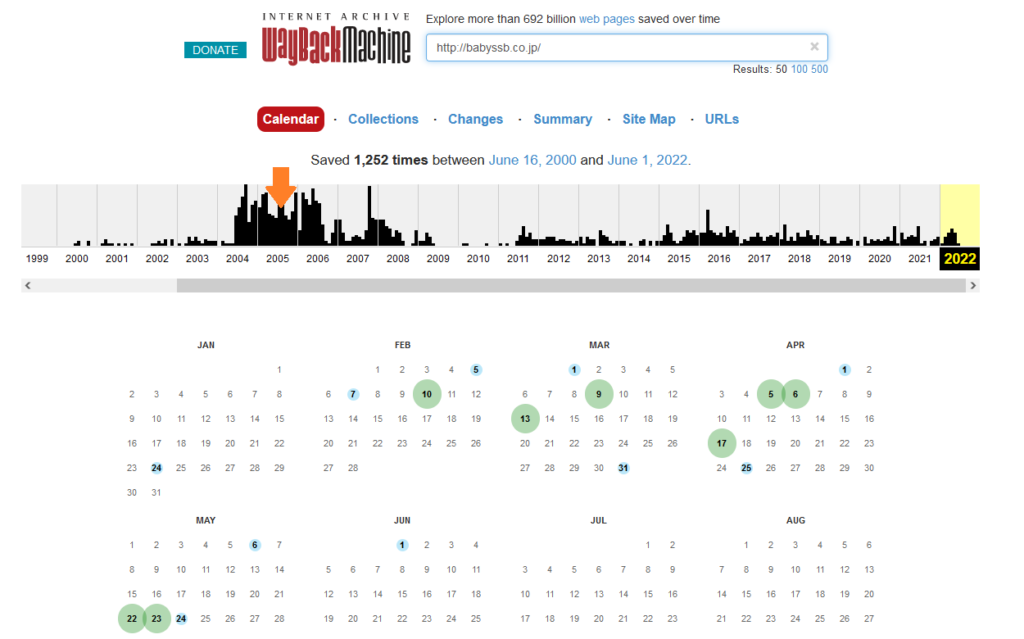
Hover over a date, and then click a time in the popup. Let’s look at the Baby site on Feb 10th 2005
Navigate to the page with the items of the type you are interested in. Older sites may use frames. Right-click and do open in a new tab instead of clicking if the URL doesn’t change when you click. Like when I click on shopping, this URL doesn’t change.
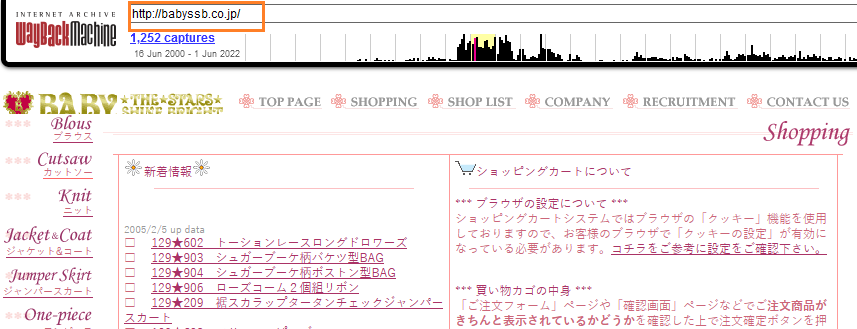
So I’m going to right click and open shopping (or actually in this case, I’m going to do Cutsew on the left).
So now, I have this URL in my new tab: https://web.archive.org/web/20050208172315fw_/http://www.babyssb.co.jp/shopping/cutsaw/index.html
I’m going to chop off the wayback part so I just have: http://www.babyssb.co.jp/shopping/cutsaw/index.html and then I’m going to go back to my original tab and paste that in to the wayback machine box (1). This will let me use the date browser at the top to tab through the date for this page. This is kind of annoying because I have to get back to the date I wanted by clicking into that year on the time line (2).
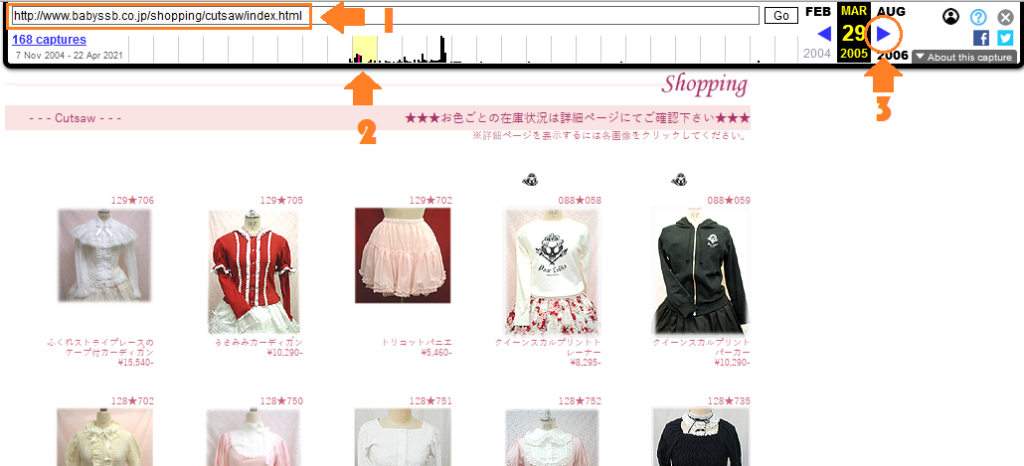
However once you do that, you can then use the arrows (3) to go backwards and forwards in time on this particular page. Step forwards capture by capture and check what is on the page to see if you see the item you are trying to identify. Sometimes there won’t be thumbnails. In those cases, translate the item names using google translate or your browser and try clicking on any that sound promising. Sometimes the subpages will have an image left. Or sometimes the subpages won’t exist. It’s a mixed bag honestly.
Step 6: Hit the Books
If you have an approximate year and you have any lolita magazines from that year, flip through them and see if you have any pictures of the item. The GLB, GLP and Kera will list the name of the item and the price in the caption of most images that aren’t street snaps.
Usually the item name is the last thing before the price at the end for the GLB/Kera on pages that show items. So you can find the last period in the description before the price, and then whatever before that is the item name… usually.
If you don’t have your own collection on publications, you can flip through the scans on lolita history to research your item. Keep in mind that those images are posted only for research purposes, and we strongly encourage you to purchase a copy of any of the publications you enjoy when possible. Because of this, lolita history mainly only posts older things.
Lolita History is indexed by google and google tries to do OCR (Optical Character Recognition on the pages) and they try to identify things in pictures. So if you have a very simple search string like the brand name, or the work ouji, and do an image search restricted to just lolita history, sometimes it can help you find what book to look at.
For example if you go to images.google.com and put in this search string:
Putumayo site:www.lolitahistory.com/gallery/
It will generally return a percentage of the GLB pages that feature Putumayo. It’s not perfect, it’s probably half or less of the pages of Putumayo, but it can be quicker than paging through everything if you have an idea of what you are looking for. I use this a lot when I can picture the page in my head, but I forget what volume of the GLB that specific page is in.
Step 7: Check Socials
For Chinese indie brand items, I will search the brand name on both the Chinese Lolita Updates page on Facebook and Loki Doki Doki’s Facebook page and scroll through all the results. And then, if that doesn’t pan out, I try to find the brand’s weibo and start searching there. You can try a keyword in the search on the brand’s weibo page, or if you have a lot of time, just start scrolling back.
For Japanese brands, I search twitter. First, locate one or more twitter handles for the brand you are interested in. (You can check the members of my JFashion Twitter list if you can’t find them easily), then pick a keyword you think might be in a tweet about the item. Simple is best. So, I might try something like ‘One Piece’ or ‘Violets’ in Japanese. Also, if you can figure out the year from the item number, you can restrict for the year. Here is an example of an advanced twitter search:
ワンピース (from:iw_osaka) until:2018-12-31 since:2018-01-01 -filter:replies
This searches for ‘ワンピース’ (OP).
It only searches for this word on the twitter @iw_osaka
It only searches for tweets from before Dec31st, 2018
It only searches for tweets from after Jan 1st 2018
And lastly, it skips replies (leave -filter:replies off unless the twitter you are searching replies to customers a lot).
So if I had an Innocent World OP where the item number started with an 18, this would show me any tweets from 2018 that contained OP and hopefully, help me find a tweet about the item.
Step 8: Look for Other Cuts of the Same Item
At this point, we are running low on places to look. I would go back through everything and look for other cuts. So if I was looking for an OP, I might look for a JSK or a Skirt in the same fabric. Sometimes you can place a piece roughly by finding other brands that used the same fabric (for commercial fabrics), or finding other pieces from the same brand in the same print.
Ask for Help
Finally, if you can’t identify something, ask for help. You can post in the Item Identification channel on the Lolibrary Discord, or try the What is That Dress (Lolita Fashion) group on facebook.
When asking for help, include the following:
- If you own the item or not
- If you own it, include clear photos of the item, and it’s tags
- If you own it, give a brief explanation of any interesting features (The back has a dot tulle bustle. There is a print of rabbits), as some of these things can be hard to see clearly in photos.
- If you own it, where you bought it (bought from a Japanese auction, bought at a local swap meet) and approximately when
- The color if it’s brown, wine, black, navy or any other dark color
- The brand, if you know it
- If you don’t own it… where the photo came from and a link to that location if possible. Sometimes an extra set of eyes can gain extra info from sales listings, blog posts, etc that you might not have caught.
Do you have any tricks you use to help identify items? Share them in the comments!
Also be sure to check out the other Bibliotheca bloggers if you haven’t already, and if you would like to get a monthly newsletter with all the Bibliotheca posts, you can subscribe to get it in your email inbox.
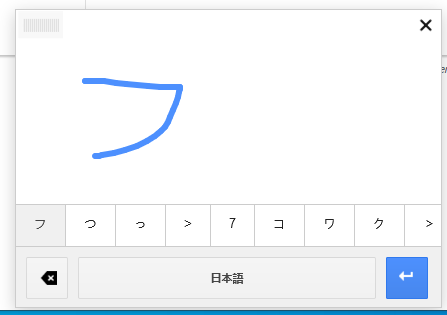

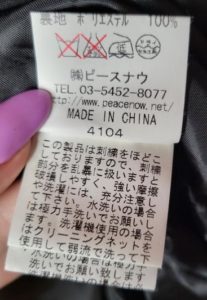
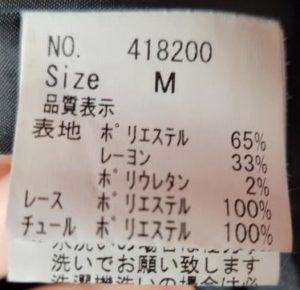

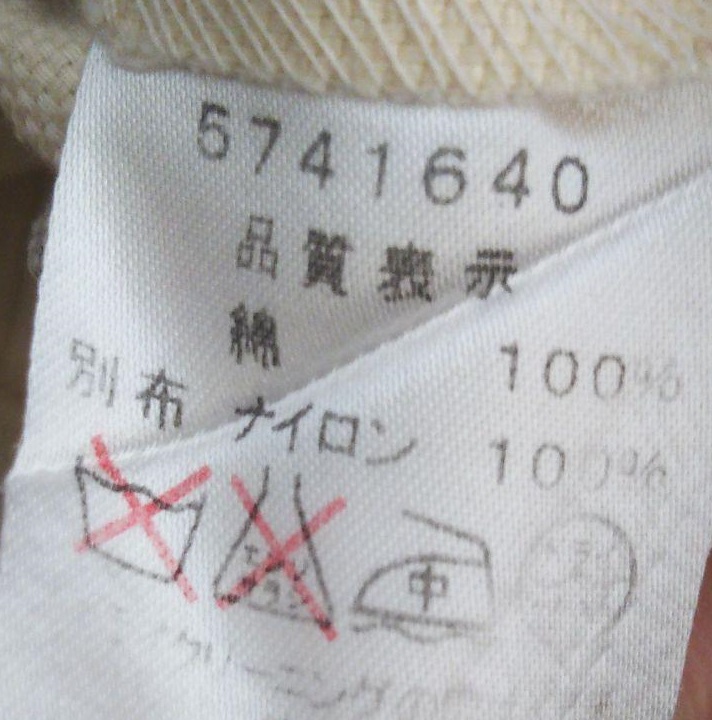
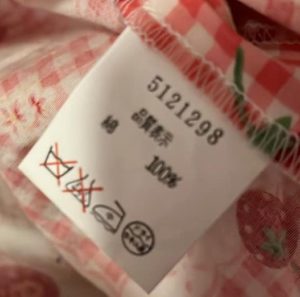
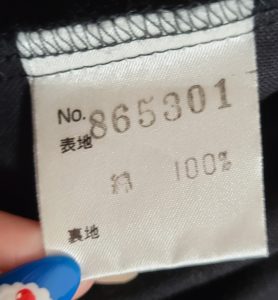

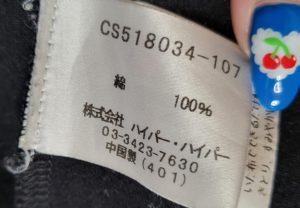




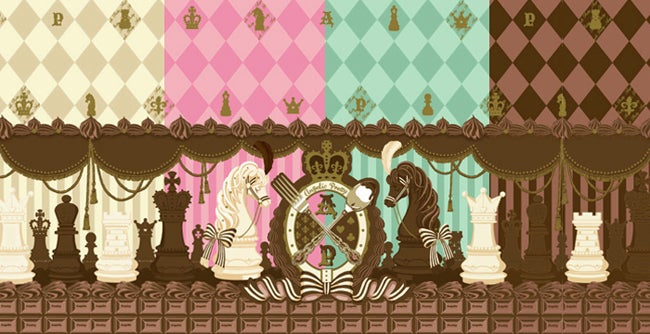


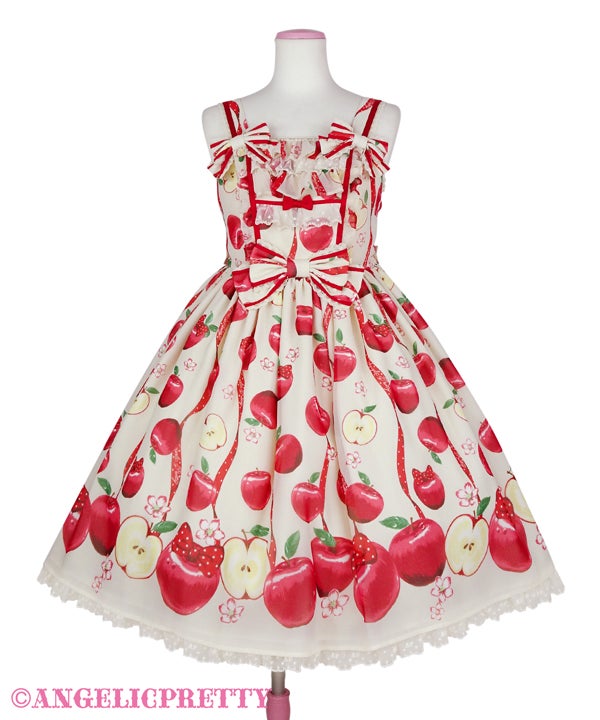
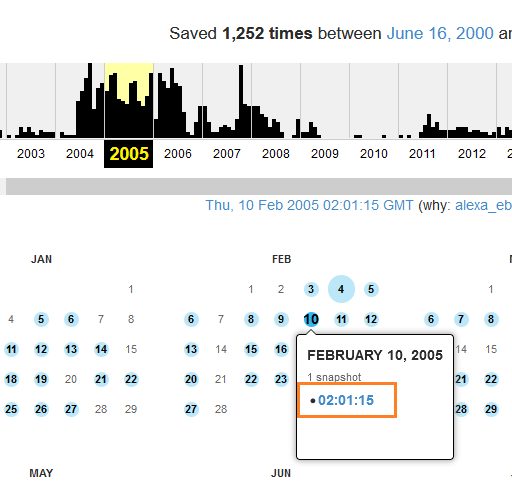

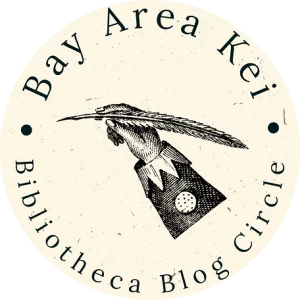
Awesome stuff! I was able to determine my mystery ETC cardigan is from 2005 🙂
Would there be any interest in seeing if years could be determined from Pink House tags? I have so many PH pieces where I only know the year because the seller said so or I found it on Club Candy and they knew the info. I’m curious if their tags have a discernable system to them.
So, pretty much all of my PH is ‘vintage’ from the 90s, and that’s the time range I collected catalogs for, so the information I have about PH item numbers is mostly 90s. That said, here is a very quick tag guide for the 90s items I’ve identified against my catalog books: http://www.rainedragon.com/pink-house-tag-guide/
For 90s PH, the tag item numbers are something like this: P0123FA27 where P01 is common to all the 90s tags, the next digit is the last digit of the year. So in this case, it’s a 2, so this is 1992. The 3 I don’t know what it means. The FA means it’s a dress (FB is blouse, FS is skirt), and then the 27 I don’t know what it means. But that 4th digit, right after the P01, is pretty much always the last digit of the year for the 90s ones.
I don’t know about the 2000s or the modern tags.
If you have any PH items you want help identifying, feel free to post in the lolibrary discord, or I made a PH facebook group a while ago that never really took off that we could use if you prefer FB: https://www.facebook.com/groups/477946162630171
I just realized I wasn’t clear, I mean, I have all the catalogs and most of them have the listing sheet of the item names + prices, so I literally can just look things from the 90s up in a couple minutes if you give me the item number and a photo XD